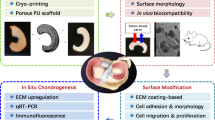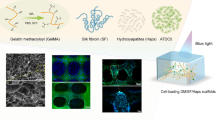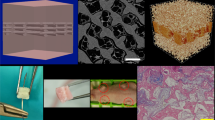Abstract
The complex meniscus tissue plays a critical role in the knee. The high susceptibility to injury has led to an intense pursuit for better tissue engineering regenerative strategies, where scaffolds play a major role. In this study, indirect printed hierarchical multilayered scaffolds composed by a silk fibroin (SF) upper layer and an 80/20 (w/w) ratio of SF/ionic-doped β-tricalcium phosphate (TCP) bottom layer were developed. Furthermore, a comparative analysis between two types of scaffolds produced using different SF concentrations, i.e., 8% (w/v) (Hi8) and 16% (w/v) (Hi16) was performed. In terms of architecture and morphology, the produced scaffolds presented homogeneous porosity in both layers and no differences were observed when comparing both scaffolds. A decrease in terms of mechanical performance of the scaffolds was observed when SF concentration decreased from 16 to 8% (w/v). Hi16 revealed a static compressive modulus of 0.66 ± 0.05 MPa and dynamical mechanical properties ranging from 2.17 ± 0.25 to 3.19 ± 0.38 MPa. By its turn, Hi8 presented a compressive modulus of 0.27 ± 0.08 MPa and dynamical mechanical properties ranging from 1.03 ± 0.08 MPa to 1.56 ± 0.13 MPa. In vitro bioactivity studies showed formation of apatite crystals onto the surface of Hi8 and Hi16 bottom layers. Human meniscus cells (hMCs) and human primary osteoblasts were cultured separately onto the top layer (SF8 and SF16) and bottom layer (SF8/TCP and SF16/TCP) of the hierarchical scaffolds Hi8 and Hi16, respectively. Both cell types showed good adhesion and proliferation as denoted by the live/dead staining, Alamar Blue assay and DNA quantification analysis. Subcutaneous implantation in mice revealed weak inflammation and scaffold’s integrity. The hierarchical indirect printed SF scaffolds can be promising candidate for meniscus TE scaffolding applications due their suitable mechanical properties, good biological performance and possibility of being applied in a patient-specific approach.







Similar content being viewed by others
References
Khetia EA, McKeon BP (2007) Meniscal allografts: biomechanics and techniques. Sports Med Arthrosc Rev 15(3):114–120. https://doi.org/10.1097/JSA.0b013e3180dca217
Mordecai SC, Al-Hadithy N, Ware HE, Gupte CM (2014) Treatment of meniscal tears: an evidence based approach. World J Orthop 5(3):233–241. https://doi.org/10.5312/wjo.v5.i3.233
Abrams GD, Frank RM, Gupta AK, Harris JD, McCormick FM, Cole BJ (2013) Trends in meniscus repair and meniscectomy in the United States, 2005–2011. Am J Sports Med 41(10):2333–2339. https://doi.org/10.1177/0363546513495641
Costa JB, Oliveira JM, Reis RL (2017) Biomaterials in meniscus tissue engineering. In: Oliveira JM, Reis RL (eds) Regenerative strategies for the treatment of knee joint disabilities. Springer International Publishing, Cham, pp 249–270. https://doi.org/10.1007/978-3-319-44785-8_13
Costa JB, Pereira H, Espregueira-Mendes J, Khang G, Oliveira JM, Reis RL (2017) Tissue engineering in orthopaedic sports medicine: current concepts. J ISAKOS Joint Disord Orthop Sports Med 2(2):60. https://doi.org/10.1136/jisakos-2016-000080
Cengiz IF, Pitikakis M, Cesario L, Parascandolo P, Vosilla L, Viano G, Oliveira JM, Reis RL (2016) Building the basis for patient-specific meniscal scaffolds: from human knee MRI to fabrication of 3D printed scaffolds. Bioprinting 1–2:1–10. https://doi.org/10.1016/j.bprint.2016.05.001
Haglin JM, Eltorai AE, Gil JA, Marcaccio SE, Botero-Hincapie J, Daniels AH (2016) Patient-specific orthopaedic implants. Orthop Surg 8(4):417–424. https://doi.org/10.1111/os.12282
Houben A, Van Hoorick J, Van Erps J, Thienpont H, Van Vlierberghe S, Dubruel P (2017) Indirect rapid prototyping: opening up unprecedented opportunities in scaffold design and applications. Ann Biomed Eng 45(1):58–83. https://doi.org/10.1007/s10439-016-1610-x
Lee M, Dunn JCY, Wu BM (2005) Scaffold fabrication by indirect three-dimensional printing. Biomaterials 26(20):4281–4289. https://doi.org/10.1016/j.biomaterials.2004.10.040
Lee JY, Choi B, Wu B, Lee M (2013) Customized biomimetic scaffolds created by indirect three-dimensional printing for tissue engineering. Biofabrication 5(4):045003. https://doi.org/10.1088/1758-5082/5/4/045003
Park JH, Jung JW, Kang HW, Cho DW (2014) Indirect three-dimensional printing of synthetic polymer scaffold based on thermal molding process. Biofabrication 6(2):025003. https://doi.org/10.1088/1758-5082/6/2/025003
Wai-Yee Y, Chee-Kai C, Kah-Fai L, Margam C, Mun-Wai L (2006) Indirect fabrication of collagen scaffold based on inkjet printing technique. Rapid Prototyp J 12(4):229–237. https://doi.org/10.1108/13552540610682741
Liu CZ, Xia ZD, Han ZW, Hulley PA, Triffitt JT, Czernuszka JT (2008) Novel 3D collagen scaffolds fabricated by indirect printing technique for tissue engineering. J Biomed Mater Res Part B Appl Biomater 85(2):519–528. https://doi.org/10.1002/jbm.b.30975
Tan JY, Chua CK, Leong KF (2010) Indirect fabrication of gelatin scaffolds using rapid prototyping technology. Virtual Phys Prototyp 5(1):45–53. https://doi.org/10.1080/17452751003759144
Liu MJ, Chou SM, Chua CK, Tay BC, Ng BK (2013) The development of silk fibroin scaffolds using an indirect rapid prototyping approach: morphological analysis and cell growth monitoring by spectral-domain optical coherence tomography. Med Eng Phys 35(2):253–262. https://doi.org/10.1016/j.medengphy.2011.09.029
Chen CH, Liu J, Chua C-K, Chou S-M, Shyu V, Chen J-P (2014) Cartilage tissue engineering with silk fibroin scaffolds fabricated by indirect additive manufacturing technology. Materials 7(3):2104
Yan LP, Oliveira JM, Oliveira AL, Reis RL (2017) Core-shell silk hydrogels with spatially tuned conformations as drug-delivery system. J Tissue Eng Regen Med 11(11):3168–3177. https://doi.org/10.1002/term.2226
Yan LP, Silva-Correia J, Ribeiro VP, Miranda-Goncalves V, Correia C, da Silva Morais A, Sousa RA, Reis RM, Oliveira AL, Oliveira JM, Reis RL (2016) Tumor growth suppression induced by biomimetic silk fibroin hydrogels. Sci Rep 6:31037. https://doi.org/10.1038/srep31037
Buckland DM, Sadoghi P, Wimmer MD, Vavken P, Pagenstert GI, Valderrabano V, Rosso C (2015) Meta-analysis on biomechanical properties of meniscus repairs: are devices better than sutures? Knee Surg Sports Traumatol Arthrosc 23(1):83–89. https://doi.org/10.1007/s00167-014-2966-9
Pina S, Vieira SI, Rego P, Torres PM, da Cruz e Silva OA, da Cruz e Silva EF, Ferreira JM (2010) Biological responses of brushite-forming Zn- and ZnSr- substituted beta-tricalcium phosphate bone cements. Eur Cells Mater 20:162–177
Pina S, Canadas RF, Jimenez G, Peran M, Marchal JA, Reis RL, Oliveira JM (2017) Biofunctional ionic-doped calcium phosphates: silk fibroin composites for bone tissue engineering scaffolding. Cells Tissues Org 204(3–4):150–163. https://doi.org/10.1159/000469703
Gruchenberg K, Ignatius A, Friemert B, von Lubken F, Skaer N, Gellynck K, Kessler O, Durselen L (2015) In vivo performance of a novel silk fibroin scaffold for partial meniscal replacement in a sheep model. Knee Surg Sports Traumatol Arthrosc 23(8):2218–2229. https://doi.org/10.1007/s00167-014-3009-2
Wojtyla S, Klama P, Baran T (2017) Is 3D printing safe? Analysis of the thermal treatment of thermoplastics: ABS, PLA, PET, and nylon. J Occup Environ Hyg 14(6):D80–d85. https://doi.org/10.1080/15459624.2017.1285489
Tas AC (2000) Synthesis of biomimetic Ca-hydroxyapatite powders at 37 degrees C in synthetic body fluids. Biomaterials 21(14):1429–1438
Yan LP, Silva-Correia J, Oliveira MB, Vilela C, Pereira H, Sousa RA, Mano JF, Oliveira AL, Oliveira JM, Reis RL (2015) Bilayered silk/silk-nanoCaP scaffolds for osteochondral tissue engineering: in vitro and in vivo assessment of biological performance. Acta Biomater 12:227–241. https://doi.org/10.1016/j.actbio.2014.10.021
Beaufils P, Becker R, Kopf S, Matthieu O, Pujol N (2017) The knee meniscus: management of traumatic tears and degenerative lesions. EFORT Open Rev 2(5):195–203. https://doi.org/10.1302/2058-5241.2.160056
Vrancken ACT, Buma P, van Tienen TG (2013) Synthetic meniscus replacement: a review. Int Orthop 37(2):291–299. https://doi.org/10.1007/s00264-012-1682-7
Hendrikx S, Kascholke C, Flath T, Schumann D, Gressenbuch M, Schulze FP, Hacker MC, Schulz-Siegmund M (2016) Indirect rapid prototyping of sol-gel hybrid glass scaffolds for bone regeneration – effects of organic crosslinker valence, content and molecular weight on mechanical properties. Acta Biomater 35:318–329. https://doi.org/10.1016/j.actbio.2016.02.038
Ahmad SN, Hashim J, Ghazali MI (2005) The effects of porosity on mechanical properties of cast discontinuous reinforced metal-matrix composite. J Compos Mater 39(5):451–466. https://doi.org/10.1177/0021998305047096
Annabi N, Nichol JW, Zhong X, Ji C, Koshy S, Khademhosseini A, Dehghani F (2010) Controlling the porosity and microarchitecture of hydrogels for tissue engineering. Tissue Eng Part B Rev 16(4):371–383. https://doi.org/10.1089/ten.TEB.2009.0639
Wu X, Black L, Santacana-Laffitte G, Patrick CW Jr (2007) Preparation and assessment of glutaraldehyde-crosslinked collagen-chitosan hydrogels for adipose tissue engineering. J Biomed Mater Res Part A 81(1):59–65. https://doi.org/10.1002/jbm.a.31003
Loh QL, Choong C (2013) Three-dimensional scaffolds for tissue engineering applications: role of porosity and pore size. Tissue Eng Part B Rev 19(6):485–502. https://doi.org/10.1089/ten.TEB.2012.0437
Critchley SE, Kelly DJ (2017) Bioinks for bioprinting functional meniscus and articular cartilage. J 3D Print Med 1(4):269–290. https://doi.org/10.2217/3dp-2017-0012
Zhang H, Zhou L, Zhang W (2014) Control of scaffold degradation in tissue engineering: a review. Tissue Eng Part B Rev 20(5):492–502. https://doi.org/10.1089/ten.TEB.2013.0452
Brown J, Lu CL, Coburn J, Kaplan DL (2015) Impact of silk biomaterial structure on proteolysis. Acta Biomater 11:212–221. https://doi.org/10.1016/j.actbio.2014.09.013
Ghanaati S, Orth C, Unger RE, Barbeck M, Webber MJ, Motta A, Migliaresi C, James Kirkpatrick C (2010) Fine-tuning scaffolds for tissue regeneration: effects of formic acid processing on tissue reaction to silk fibroin. J Tissue Eng Regen Med 4(6):464–472. https://doi.org/10.1002/term.257
Cao Y, Wang B (2009) Biodegradation of silk biomaterials. Int J Mol Sci 10(4):1514–1524. https://doi.org/10.3390/ijms10041514
Wang Y, Rudym DD, Walsh A, Abrahamsen L, Kim HJ, Kim HS, Kirker-Head C, Kaplan DL (2008) In vivo degradation of three-dimensional silk fibroin scaffolds. Biomaterials 29(24–25):3415–3428. https://doi.org/10.1016/j.biomaterials.2008.05.002
Kim UJ, Park J, Joo Kim H, Wada M, Kaplan DL (2005) Three-dimensional aqueous-derived biomaterial scaffolds from silk fibroin. Biomaterials 26(15):2775–2785. https://doi.org/10.1016/j.biomaterials.2004.07.044
Ribeiro VP, Pina S, Costa JB, Cengiz IF, García-Fernández L, Fernández-Gutiérrez MdM, Paiva OC, Oliveira AL, San-Román J, Oliveira JM, Reis RL (2019) Enzymatically cross-linked silk fibroin-based hierarchical scaffolds for osteochondral regeneration. ACS Appl Mater Interfaces 11(4):3781–3799. https://doi.org/10.1021/acsami.8b21259
Ribeiro VP, da Silva Morais A, Maia FR, Canadas RF, Costa JB, Oliveira AL, Oliveira JM, Reis RL (2018) Combinatory approach for developing silk fibroin scaffolds for cartilage regeneration. Acta Biomater 72:167–181. https://doi.org/10.1016/j.actbio.2018.03.047
Abdelgaied A, Stanley M, Galfe M, Berry H, Ingham E, Fisher J (2015) Comparison of the biomechanical tensile and compressive properties of decellularised and natural porcine meniscus. J Biomech 48(8):1389–1396. https://doi.org/10.1016/j.jbiomech.2015.02.044
Shriram D, Praveen Kumar G, Cui F, Lee YHD, Subburaj K (2017) Evaluating the effects of material properties of artificial meniscal implant in the human knee joint using finite element analysis. Sci Rep 7(1):6011. https://doi.org/10.1038/s41598-017-06271-3
Lee JH, Kisiday J, Grodzinsky AJ (2003) Tissue-engineered versus native cartilage: linkage between cellular mechano-transduction and biomechanical properties. In: Novartis foundation symposium 249:52–64; discussion 64–59, 170–174, 239–141
Pereira H, Caridade SG, Frias AM, Silva-Correia J, Pereira DR, Cengiz IF, Mano JF, Oliveira JM, Espregueira-Mendes J, Reis RL (2014) Biomechanical and cellular segmental characterization of human meniscus: building the basis for tissue engineering therapies. Osteoarthr Cartil 22(9):1271–1281. https://doi.org/10.1016/j.joca.2014.07.001
Bursac P, Arnoczky S, York A (2009) Dynamic compressive behavior of human meniscus correlates with its extra-cellular matrix composition. Biorheology 46(3):227–237. https://doi.org/10.3233/bir-2009-0537
Chia HN, Hull ML (2008) Compressive moduli of the human medial meniscus in the axial and radial directions at equilibrium and at a physiological strain rate. J Orthop Res 26(7):951–956. https://doi.org/10.1002/jor.20573
Mandal BB, Park S-H, Gil ES, Kaplan DL (2011) Multilayered silk scaffolds for meniscus tissue engineering. Biomaterials 32(2):639–651. https://doi.org/10.1016/j.biomaterials.2010.08.115
Nazarov R, Jin H-J, Kaplan DL (2004) Porous 3-D scaffolds from regenerated silk fibroin. Biomacromol 5(3):718–726. https://doi.org/10.1021/bm034327e
Stoffel M, Weichert D, Müller-Rath R (2008) Mechanical modelling and experimental validation of meniscus replacement material. PAMM 8(1):10197–10198. https://doi.org/10.1002/pamm.200810197
Bose S, Fielding G, Tarafder S, Bandyopadhyay A (2013) Understanding of dopant-induced osteogenesis and angiogenesis in calcium phosphate ceramics. Trends Biotechnol 31(10):594–605. https://doi.org/10.1016/j.tibtech.2013.06.005
Vepari C, Kaplan DL (2007) Silk as a biomaterial. Prog Polym Sci 32(8–9):991–1007. https://doi.org/10.1016/j.progpolymsci.2007.05.013
Yao D, Liu H, Fan Y (2016) Silk scaffolds for musculoskeletal tissue engineering. Exp Biol Med 241(3):238–245. https://doi.org/10.1177/1535370215606994
Samavedi S, Whittington AR, Goldstein AS (2013) Calcium phosphate ceramics in bone tissue engineering: a review of properties and their influence on cell behavior. Acta Biomater 9(9):8037–8045. https://doi.org/10.1016/j.actbio.2013.06.014
Zhang Y, Wu C, Friis T, Xiao Y (2010) The osteogenic properties of CaP/silk composite scaffolds. Biomaterials 31(10):2848–2856. https://doi.org/10.1016/j.biomaterials.2009.12.049
Mandal BB, Gil ES, Panilaitis B, Kaplan DL (2013) Laminar silk scaffolds for aligned tissue fabrication. Macromol Biosci 13(1):48–58. https://doi.org/10.1002/mabi.201200230
Xie H, Wang J, He Y, Gu Z, Xu J, Li L, Ye Q (2017) Biocompatibility and safety evaluation of a silk fibroin-doped calcium polyphosphate scaffold copolymer in vitro and in vivo. RSC Adv 7(73):46036–46044. https://doi.org/10.1039/C7RA04999D
Kundu B, Rajkhowa R, Kundu SC, Wang X (2013) Silk fibroin biomaterials for tissue regenerations. Adv Drug Deliv Rev 65(4):457–470. https://doi.org/10.1016/j.addr.2012.09.043
Acknowledgements
The authors thank the financial support provided by the Portuguese Foundation for Science and Technology (FCT) through the projects B-FABULUS (PTDC/BBB-ECT/2690/2014) and Fun4TE (PTDC/EMD-EMD/31367/2017). FCT/MCTES is also acknowledged for the PhD scholarship attributed to J.B.C. (PD/BD/113803/2015) and the financial support provided to J.S.-C. (IF/00115/2015) and J.M.O. (IF/01285/2015) under the program “Investigador FCT.” The authors would like to also acknowledge the contribution of Teresa Oliveira for histology samples processing.
Author information
Authors and Affiliations
Corresponding author
Ethics declarations
Conflict of interest
All the authors declare that they have no conflict of interest.
Ethical approval
This article does not contain any studies with human or animal subjects performed by any of the author.
Electronic supplementary material
Below is the link to the electronic supplementary material.
Rights and permissions
About this article
Cite this article
Costa, J.B., Silva-Correia, J., Pina, S. et al. Indirect printing of hierarchical patient-specific scaffolds for meniscus tissue engineering. Bio-des. Manuf. 2, 225–241 (2019). https://doi.org/10.1007/s42242-019-00050-x
Received:
Accepted:
Published:
Issue Date:
DOI: https://doi.org/10.1007/s42242-019-00050-x




